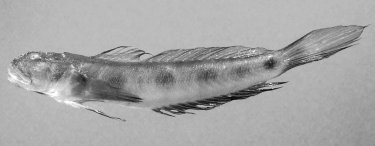
|
Relevant synonyms
Misidentification
Meristic formula
|
|
| photo : David Darom |
|
SHORT
DESCRIPTION
color :
back greenish grey with pale belly. A series of 4-5 dark blotches on the sides and a black spot on caudal fin base. The flap on the upper edge of eye is bright orange.
size :
common 7-12 cm (max. 15 cm). |
DISTINGUISHING CHARACTERISTICS
BIOLOGY / ECOLOGY
habitat :
benthic, sandy or muddy substrate to depths of 70 m. |
|
1st
MEDITERRANEAN RECORD
|

|
|
DISTRIBUTION
|
ESTABLISHMENT SUCCESS
speculated reasons for success :
|
|
|
MODE OF
INTRODUCTION |
IMPORTANCE TO
HUMANS |
|
KEY
REFERENCES
|
 Oxyurichthys papuensis
Oxyurichthys papuensis